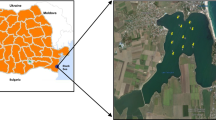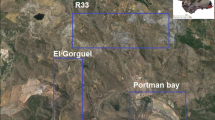Abstract
This study aimed to chemically and radiologically characterize the water resources influenced by a phosphogypsum stack in Imbituba, SC, Brazil and to identify the annual intake by ingestion. Surface water was collected at six points downstream of the phosphogypsum stack. Subsurface water samples were collected from a piezometer in the stack area. These samples were analyzed using a radiochemical method to determine the natural radionuclide content and an inductively coupled plasma optical emission spectrometry to determine the concentration of selected metals. The concentrations of radionuclides were also compared with current standards. The radionuclide concentrations in the surface waters samples were lower or similar to those found in other studies. The effective dose resulting from water ingestion is below the recommended reference levels for drinking water. Samples collected exhibited no increase in radioactivity, under the influence of phosphogypsum stacks.




Similar content being viewed by others
References
Borges, R. C. (2011). Caracterização Química e Radiológica do Fosfogesso de Imbituba – SC e Aspectos Ambientais do Uso na Recuperação de Solos Agrícolas. 2011. Thesis (Doctorate) – Geoquímica Ambiental, Universidade Federal Fluminense, Niterói – RJ.
Carvalho, F. P. (1997). Dsitribution, cycling and mean residence time of 226Ra, 210Pb and 210Po in the Tagus estuary. Science of the Total Environment, 196, 151–161.
Choukri, A., Abrahimi, M., Reyss, J. L., Hakam, O. K., Moutia, Z., Bounouira, H., et al. (2002). Measurement of activities of some radionuclides in some water and sediment samples from region of the Moulouya river at the Northeast of Morocco. [S.l.: s.n.].
CNEN (2005). Coeficientes de dose oara exposição do público. Posição Regulatória 3.01/011. Rio de Janeiro. Comissão Nacional de Energia Nuclear.
CONAMA (2009). Conselho Nacional de Meio Ambiente. Resolução n°420/2009, Brazil. http://www.mma.gov.br/port/conama/legiabre.cfm?codlegi=620. Accessed 2 January 2013.
Einax, J. W., & Soldt, U. (1999). Geostatistical and multivariate statistical methods for the assessment of polluted soils—merits and limitations. Chemometrics and Intelligent Laboratory Systems, 46, 79–91.
Grassi, M. T., Shi, B., Ma, H., Allen, H. E. (1997). Partição do cobre entre a coluna d’água e o material particulado suspenso. In: 20a Annual Meeting of SBQ –MG., v. 3, Annals – Poços de Caldas.
Godoy, J. M. (1990). Methods for measuring radium isotopes: gross alpha and gross beta counting. In International Atomic Energy Agency, the environmental behaviour of Radium. Technical Report Series, 310. Vol 1. c.3–5. Vienna.
Godoy, J. M., & Godoy, M. L. (2006). Natural radioactivity in Brazilian groundwater. Journal of Environmental Radioactivity, 85(1), 71–83.
Harris, D. C. (2005). Análise Química Quantitativa (6.ed). Rio de Janeiro: LTC.
International Atomic Energy Agency – IAEA. (1990). Environmental behavior of Radium. Technical Report Series N° 310. IAEA, Vienna.
International Atomic Energy Agency. (2011). International basic safety standards (BSS). Vienna: International Atomic Energy Agency. 284 p.
Joseph, A. B., Gustafison, P. F., Russell, I. F. (1971). Sources of radioactivity and their characteristics. In National Research Council (Ed.), Radioactivity in the marine environment, chapter 2. Washington D. C.: National Academy of Science.
Lacerda, L. D., Paraquetti, H. H. M., Molisani, Bernardes, M. C. (2007). Transporte de Materiais na Interface Continente-Mar na Baía de Sepetiba, Rio de Janeiro. XII Congresso Latino-americano de ciências do mar. Florianópolis, Brazil.
Lauria, D. C., & Godoy, J. M. (1988). A sequential method for the determination of 238U, 232Th, 230Th, 228Th, 228Ra and 226Ra in environmental samples. The Science of the Total Environmental, 70, 83–99.
MS (2011). Ministério da Saúde. Portaria n°2914/2011. http://bvsms.saude.gov.br/bvs/saudelegis/gm/2011/prt2914_12_12_2011.html. Accessed 2 January 2013.
Paul, S. K. (2001). Geochemistry of botton sediments from a river-estuary-shelf mixing zone on the tropical southwest coast of India. Bulletin of the Geological Survey of Janpan, 52, 371–382.
Pelegrina, J. M. A., & Martinez-Aguirre, A. (2001). Natural radioactivity in groundwaters around a fertilizer factory complex in South of Spain. Applied Radiation and Isotopes, 55, 419–423.
Petry, C. F. (2005). Determinação de elementos traços em amostras ambientais por ICP/OES. 90 f. Dissertação (Mestrado em Química). Instituto de Química, Universidade Federal do Rio Grande do Sul, UFRS, Porto Alegre, RS, Brasil.
Santos, A. J. G. (2002). Avaliação do impacto radiológico ambiental do phosphogypsum brasileiro e lixiviação de 226Ra e 210Pb. 2002. 165 f. Thesis (Doctorate) - Instituto de Pesquisas Energéticas e Nucleares, São Paulo.
Silva, N. C. (2001). Radionuclídeos naturais e elementos tóxicos em pilhas de fosfogesso no Brasil: caracterização e lixiviação. Tese de Doutorado, Centro de Energia Nuclear na Agricultura, Universidade de São Paulo, Piracicaba.
Silva, P. S. C. (2004). Caracterização química e radiológica dos sedimentos do Estuário de Santos, São Vicente e Baía de Santos. 2004. 282 f. Thesis (Doctorate) - Instituto Astronômico e Geofísico da Universidade de São Paulo, São Paulo.
Skoog, D. A. (2002). Princípios de Análise Instrumental. Ed. Bookman, 5a. ed., Porto Alegre.
Sodré, G. S. (2005). Características físico-químicas, microbiológicas e polínicas de amostras de méis de Apis melliferaL., 1758 (Hymenoptera: Apidae) dos estados do Ceará e Piauí. 2005. 127 f. Thesis (Doctorate in Biological Sciences) - Escola Superior de Agricultura “Luiz de Queiroz”, Universidade de São Paulo, São Paulo.
Sposito, G. (1984). In: Grassi, M. T.; Shi, B.; Allen, H. E. 2000. Partition of copper between dissolved and particulate phases using aluminum oxide as an aquatic model phase: Effects of pH, solids and organic matter. Journal of the Brazilian Chemical Society, 11(5), 516–524.
United States Environmental Protection Agency. (1999). Background report on fertilizer use, contaminants and regulations. Washington D. C: USEPA.
Vianna, L. T., Tauhata, L., Oliveira, A. E., Oliveira, J. P., Clain, A. F., Ferreira, A. C. M. (1998). Evaluation of Brazilian intercomparison program data from 1991 to 1995 of radionuclide assays in environmental samples. Applied Radiation and Isotopes, 49, 1463–1466.
Acknowledgments
The authors would like to acknowledge the Conselho Nacional de Desenvolvimento Científico e Tecnológico (CNPq) and Coordenação de Aperfeiçoamento de Pessoal de Nível Superior (CAPES) for the scholarship and financial support. Authors are grateful to Mr. Ferreira for authorizing PG sample collecting.
Author information
Authors and Affiliations
Corresponding author
Rights and permissions
About this article
Cite this article
Borges, R.C., Ribeiro, F.C.A., da Costa Lauria, D. et al. Influence of Phosphogypsum Stacks on the Distribution of Natural Radionuclides in Surface and Subsurface Waters in the City of Imbituba, SC, Brazil. Water Air Soil Pollut 224, 1540 (2013). https://doi.org/10.1007/s11270-013-1540-2
Received:
Accepted:
Published:
DOI: https://doi.org/10.1007/s11270-013-1540-2




